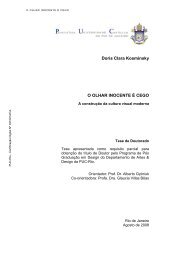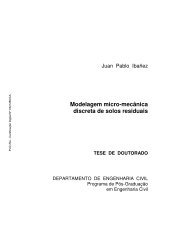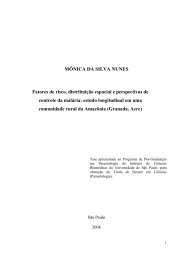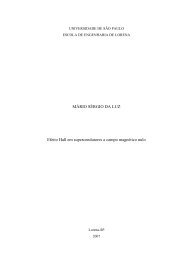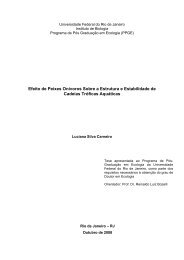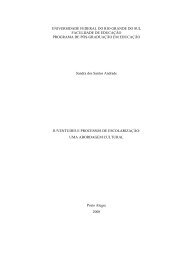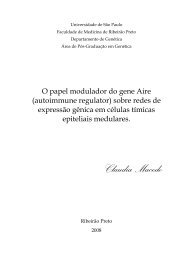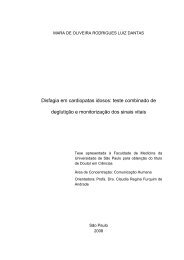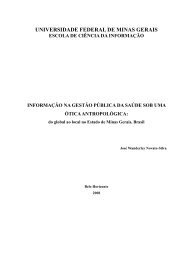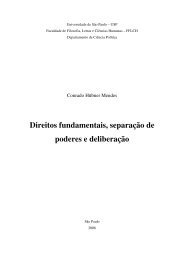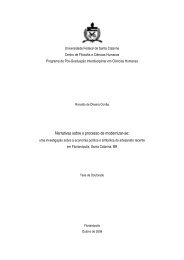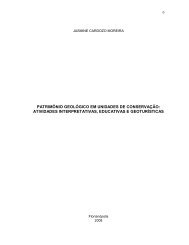Materiais moleculares funcionais contendo n-heterociclos - capes
Materiais moleculares funcionais contendo n-heterociclos - capes
Materiais moleculares funcionais contendo n-heterociclos - capes
Create successful ePaper yourself
Turn your PDF publications into a flip-book with our unique Google optimized e-Paper software.
Hockey stick-shaped LC compounds 385containing two- and four-brush disclinations, excludingthe possibility of biaxiality in these phases [24].2.3. Fluorescence propertiesCOLOURFIGUREThe UV-vis absorption and fluorescence spectroscopydata in chloroform solution for final compounds 1–7 aresummarized in table 3. Similar absorption patternsbetween 300 and 400 nm are observed with an intenseabsorption band (e>40 000 mol 21 cm 21 ) peaking between330 and 360 nm (figure 3). These compounds displayedblue emission in solution (l max. em. 5390–460 nm) withgood photoluminescence quantum yields (50–85%).Compounds 1–3 show maximum absorption peakwavelengths around 340 nm. The highest absorptionpeak wavelengths for compounds 4–6 are red-shifted bya maximum of 14 and a minimum of 7 nm comparedwith the average for compounds 1–3. On the otherhand, compound 7 shows a blue-shift in the spectrum of7 nm from 340 nm. This could be due to an electroniceffect, which lowers the HOMO-LUMO band gap dueto the presence of a strong electron-donating substituentlike the –NR 2 group (compound 6) or –OR group,together with an elongated conjugation length (4 and 5).The opposite occurs in compound 7 (blue-shift), inwhich the ester linkage breaks the conjugation. Thiseffect is also present in the fluorescence spectra.Compound 6 gave the highest emission peak wavelengthwith a large Stokes shift (106 nm). This is expected toarise from a push–pull system [25] between a strongelectron-donating group (–NR 2 ) and a strong electron–withdrawing group (oxadiazole ring). Nevertheless, thiscompound showed a lower photoluminescence quantumyield (52.4%). In addition, compounds 4 and 7 gavestructured fluorescence spectra with two and threeemission peaks, respectively. The luminescence lifetimedecay for similar compounds is around 0.7–0.9 ns [16].Based on this, and on the emission energy and quantumyields the luminescence for compounds 1–7 may beattributed to p–p* fluorescence.3. ConclusionsFigure 2. Photomicrographs of (a) the N phase schlierentexture at 221.4uC for compound 7 (33x); (b) the SmA phasefocal-conic texture at 209.1uC for compound 6 (33x); (c) theSmC phase broken fan-shaped texture at 149.2uC forcompound 6 (33x). Samples were sandwiched betweenuntreated glass slides and viewed through crossed polarizers.In summary, a series of p-conjugated bent-core unsymmetric2,5-(disubstituted)-1,3,4-oxadiazoles was preparedby convergent Sonogashira cross-couplingof building blocks between 2-(bromoarylene)-5-(ndecyloxyphenyl)-1,3,4-oxadiazoleand the correspondingterminal arylacetylenes. This versatile syntheticroute yielded luminescent unsymmetrical bent-coreliquid crystalline compounds in high yields. The mainadvantage of the synthetic pathway is the flexibility toprepare ‘tailor-made’ building blocks, for example, bysimply reversing terminal functionalities. The POM and



